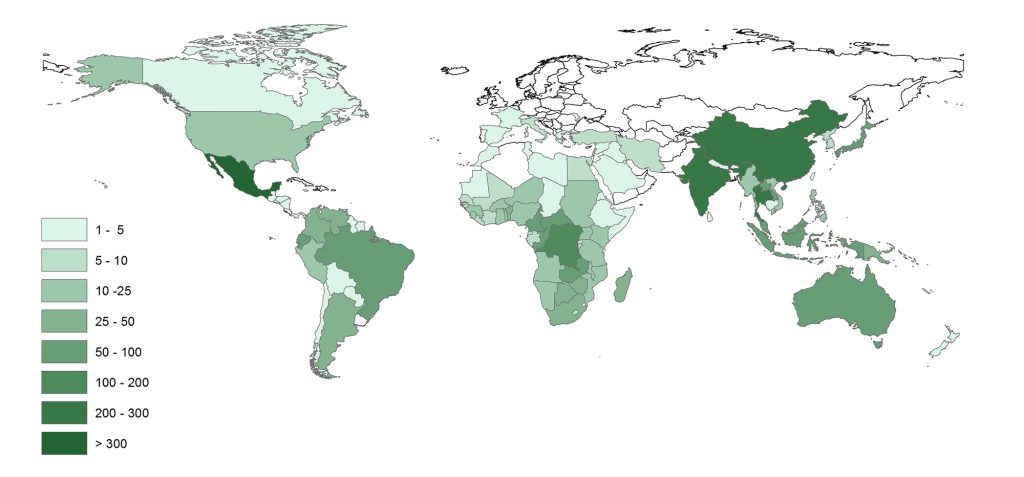Why Don’t More Humans Eat Bugs?

Ten years ago, toiling in scorching heat on the parched Fongoli savanna in southeast Senegal, anthropologist Julie Lesnik faced an unpalatable task. She had to taste a termite.
At the time, Lesnik was a doctoral student studying the evolution of the human diet by examining our closest living relatives, chimpanzees. Chimps dine on termites that they hunt by digging into mounds using tools. Lesnik mimicked this behavior, spending long days poking at different types of termite mounds at her study site. But all the while, the words of her adviser, University of Michigan’s Milford Wolpoff, haunted her: “Don’t come home from Africa until you can tell me what a termite tastes like.”
Her field assistant made it look easy. Using a stick to pull the insects out of a mound, he demonstrated how to eat them. Technique was important. “I knew I had to bite really fast, directly on the termite so it didn’t bite my tongue,” Lesnik, now based at Wayne State University in Michigan, says.
When the dreaded moment finally arrived, she acted like a picky youngster: She fidgeted. She wiggled her hands in the air. She scrunched her nose in disgust. Finally, she buckled down and bit the red-brown critter, a scant 1.5 centimeters long. The whole ordeal was anti-climactic. “It just tasted like dirt,” she recalls.
Despite that rite of passage, Lesnik had no desire to eat bugs again. It’s surprising, then, that today, a decade later, she is one of the world’s leading advocates for consuming insects. Nowadays Lesnik can scarf handfuls of dry-roasted crickets and mealworms, and she recently tried a crab cake topped with scorpions.
Her change of heart on entomophagy—the practice of eating insects—came gradually as she wrote up her dissertation. During her research, she came across people on the web touting edible insects as the “next big thing.” Spoof TV shows featured cooking demos with deep-fried tarantula tempura. Then came a widely publicized 2013 report in which the United Nations Food and Agriculture Organization declared that current farming and food production practices are inadequate for the planet’s growing population but that edible insects could help meet this need. Crickets, for instance, pack three times more protein per weight than beef or chicken. And since bugs grow well in cramped spaces, raising them requires far less land and water than traditional livestock.
By then Lesnik had done enough of her own research to buy into these claims intellectually, though she remained squeamish—a common problem in promoting “bugs as food.” Particularly in North America and Europe, many people cannot stomach the thought of creepy-crawlies on their dinner plate. Psychological factors—perhaps akin to people’s knee-jerk aversion to spiders and snakes—likely play a part in this response. Yet Lesnik suspected something else was at play: More than a quarter of the world’s population nosh on bugs on a regular basis. “There can’t be something inherent about the bugs themselves that makes them disgusting,” she says.
Instead, Lesnik realized, cultural factors contribute—a revelation that not only helped to change her ideas about eating insects but revealed a whole new avenue of research. Until recently, entomophagy has largely been the province of insect biologists, but Lesnik recognized that she and other social scientists might play a special role in studying (and changing) Western diets by untangling the influence of social history and norms. As Briana Pobiner, an anthropologist at the Smithsonian Institution in Washington, D.C., who studies the prehistory of meat-eating, says, this research can “remind those of us in (mainly Western) cultures where insect eating is uncommon, effectively nonexistent, or even frowned upon that this is not the case around the world.”
As Lesnik and others probe the diversity of human diets, they have found something that may surprise those of us who dismiss dining on bugs: Edible insects are part of our human legacy. “This food of the future is actually a valued food of the past,” says Lesnik, who described some of her research in a book, Edible Insects and Human Evolution, published in July. The fact that certain societies now reject this protein source reveals the complex tangle of geography and cultural factors that has broadly shaped many diets.
For at least 2 billion people around the globe, eating insects doesn’t feel like an exotic practice—it’s a routine part of life. In Thailand, street vendors push carts stocked with trays of deep-fried grasshoppers, water bugs, and other seasoned insects. In Mexico, chefs mix cream-colored ant eggs into omelets and whip up guacamole with crunchy grasshoppers. In Zambia, the Congo, and other parts of Africa, locals snack on insects harvested from the wild. A 2017 analysis estimates that people around the world relish more than 2,000 species of bugs.
It’s quite likely that these eating habits have very old roots. About two decades ago, paleoanthropologists Lucinda Backwell and Francesco d’Errico analyzed bone tools excavated in South Africa that were more than 1 million years old. Examined under a microscope, the tools’ ridges and other wear patterns suggested that premodern humans used these instruments to dig into termite mounds. The researchers reported those results in a 2001 paper that many experts consider solid evidence that insects were part of the ancient human diet.
Eating insects was likely pretty normal for our ancestors. So why do some populations find the notion revolting? Lesnik began gathering data to answer that question.
One popular notion she examined came from the publications of the late entomologist Gene DeFoliart. Perhaps the agricultural revolution catalyzed the departure of bugs from the Western diet. Hunter-gatherers, she reasoned, might have snacked on wild ants and beetles, but insects would have become pests once people started farming.
This hypothesis quickly crumbled. Many insectivorous countries today are also agricultural. And when Lesnik tested the idea more rigorously—by determining country by country if the percent of arable land correlates with bug-eating habits—she found no correlation.
It could be that people eat bugs more often in poor countries or as a fallback food when there isn’t enough to eat. Lesnik looked at a map showing the number of insect species consumed in each country to see if bug-eating habits correlate with gross domestic product. They don’t. Nor does insect consumption relate to population density, which you might expect if societies turn to bugs when there are too many mouths to feed.
In the end, it mostly comes down to geography, an idea previously suggested by the anthropologist Marvin Harris in the 1990s. “Latitude—where you are in the world—seems to be the number one predictor of who’s going to be eating insects,” Lesnik says. People in China and Mexico are among those who eat the most bugs—more than 300 species—whereas no edible insect species were found in Russia and Scandinavian countries near the Arctic Circle. Lesnik published these findings last year in the American Journal of Human Biology.
The results resonate with Arnold van Huis, an entomologist at Wageningen University in the Netherlands who wrote about insects as food for a 2017 book on human-animal interactions. Insects flourish in warmer areas. In the tropics, he explains, bugs are larger—and more meal worthy—than in temperate zones where many lay dormant or die in winter.
The latitude theory also jibes with human history and migration patterns. Neanderthals, humans’ closest extinct relatives, roamed what’s now Europe and Central Asia during a harsh, wintry era when ice blanketed much of their habitat.
Living in the tundra with no easy calories from fruits or vegetables, they relied on hunting deer and other creatures that ate woody plants. “The only way to survive up there was to eat animals,” Lesnik says. “And you don’t need alternative insect protein when you’re already eating meat all year round.” The Neanderthal diet may help explain food choices in the West. “If we’re tracing our history … edible insects would have been important to hominids anywhere else in the world except in those really cold environments,” Lesnik says.
Still, even if geography and climate explain how bugs faded from the Western diet, they don’t explain the deep-rooted disgust so many people feel when facing an insect or arthropod-laced meal—their knee-jerk “Ewww!”
Based on her findings about geography, Lesnik turned to history, zooming in on the Age of Exploration, beginning in the 15th century, when Europeans were crossing latitudes and exploring insect-rich equatorial regions. Here she hit a new factor: the clash of cultures.
Consider, for example, the remarks of Diego Álvarez Chanca, the fleet physician of Christopher Columbus’ 1493 Caribbean expedition. He wrote that locals “eat all the snakes, lizards, spiders, and worms that they find upon the ground so that, according to my judgment, their bestiality is greater than that of any other beast on the face of the earth.”
This attitude reflects what anthropologists call “ethnocentric bias”—the tendency to evaluate other cultures according to preconceptions based on the customs of one’s own culture. Often this sort of bias results in “othering,” seeing our own life practices as normal and regarding others’ habits as alien and substandard.
“As anthropologists, we’re trained to be very aware of this [bias] and to avoid it,” Lesnik says. “If we’re going to try to understand people from all around the world, we need to understand them from their perspective, from their values.”
But European explorers had no such training, and their attitude of superiority over the Indigenous peoples they met or observed extended to people’s choice of food. On a Caribbean voyage in 1527, one Spanish traveler described the Native people’s diet as driven by desperation: “Now and then they kill deer and at times get a fish, but this is so little and their hunger so great that they eat spiders and ant eggs, worms, lizards, and salamanders and serpents.”
A Eurocentric perspective, Lesnik says, linked eating insects with inferiority, even though for many cultures insects were traditional staples. The stigma Europeans placed on bug eating in the lands they colonized persisted such that the practice is now associated with a lower standard of living. While van Huis was doing fieldwork in Niger in the late 1990s, he noticed that many people who adopt Western customs drop bugs from their diet. “It has a lot to do with the notion of insects being a poor man’s food. They like to copy Western lifestyles and diets,” he says. “They go for the hamburger instead of the nice grasshoppers.”
Even the term “entomophagy” is problematic. “I hate the word,” says van Huis, who has argued that it resembles a disease more than a dietary descriptor. “It came about by Western people who wanted to indicate that people in the tropics had a strange habit of eating insects.”
Once a culture rejects eating insects, that norm can easily be taught from parent to offspring. As part of normal development, babies explore the world by putting virtually any object they encounter into their mouth—whether sand, socks, or a soiled diaper. It takes an adult yelling “no!” for the baby to stop. “If a kid picks up a bug and tries to put it in his mouth,” says Lesnik, “parents generally discourage that behavior and say, ‘That’s icky!’”
Can cultural disgust be unlearned? Robert Nathan Allen thinks so. Allen is the founder of Little Herds, a nonprofit in Austin, Texas, that teaches children and the public about the benefits of eating insects. He’s encouraged by the way Westerners have learned to embrace other foods, such as sushi, that initially provoked unease. “It used to be dangerous and disgusting to eat raw fish. That was common sense,” Allen says. But after chefs came up with options like the California roll, which has no raw fish, and other types of sushi with “rice on the outside to hide the weird seaweed … that’s when sushi started to pick up traction.”
Seeing how culture has shaped our palate may be persuasive. Pobiner, the Smithsonian anthropologist, for example, notes that while she doesn’t typically nosh on ants or crave crickets, eating insects is something she is “absolutely willing to try,” a change she credits to Lesnik’s research.
There’s another lesson to be learned from the historical and cultural shifts in human meals: Access matters. Westerners abandoned their ancestors’ appetite for bugs when they moved to places where these critters were less abundant and meaty. Convenience remains a reason why bugs aren’t regularly a part of even Lesnik’s meals. “I’m a lazy cook,” she says. “If I want to integrate insects into my diet, I’d need to order them online and figure out what to do with them. And they’re not cheap.”
But if suppliers can get past those hurdles while making insect foods mainstream in the West, chances to sample termite tiramisu and cricket au vin could crop up more and more. For the time being, knowing these six-legged creatures were hearty fare for our early ancestors offers something to chew on.




































